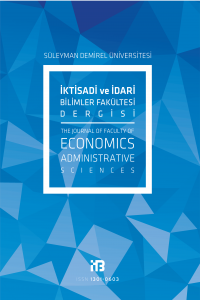NORMATİF POLİTİKA ANALİZİNDE YENİ EĞİLİM: MALİ VE PARASAL POLİTİKALARA RAMSEYCİ YAKLAŞIM
Son dönem makroiktisat yazınında normatif politika analizi optimal mali ve parasal politikalar başlığı altında Ramseyci yaklaşımla ele alınmaktadır. Ramsey ve Ramseyci terimleri politika kavramlarının belirteci haline gelmiştir. Makalede mali ve parasal politikalar bağlamında Ramseyci yaklaşım ele alınmakta ve değerlendirilmektedir. Ramsey (1927) politika problemine ekonominin kaynak kısıtı, kamunun bütçe kısıtı ve özel kesimin optimalite koşulları altında temsili hanehalkının faydasını maksimize eden politikaların belirlenmesi problemi olarak yaklaşmıştır. Yaklaşım, uygulama alanının genişlemesi şeklinde bir gelişme göstermiştir. Temsili karar birimi ekonomisi kalıplarının dışına çıkılamamış olması; vergi sisteminin, kamu harcamalarının dışsal alınması yaklaşımla elde edilen sonuçları kırılgan yapmaktadır
Anahtar Kelimeler:
Normatif politika analizi, optimal mali ve parasal politikalar, Ramseyci yaklaşım
Normatif Politika Analizinde Yeni Eğilim: Mali ve Parasal Politikalara Ramseyci Yaklaşım
Keywords:
-,
___
- 1. ATKINSON, Anthony B. ve Joseph E. STIGLITZ, Lectures on Public Policy, McGraw Hill, Maidenhead, 1980.
- 2. ATKINSON, Anthony B. ve Joseph E. STIGLITZ, “The Structure of Indirect Taxation and Economic Efficiency”, Journal of Public Economics, Cilt 1, s.97-119, 1972.
- 3. BARRO, Robert J., “On the Determination of the Public Debt”, Journal of Political Economy, Cilt 67, s. 940-947, 1979.
- 4. CASS, David, “Optimum Growth in an ggregate Model of Capital Accumulation”, Review of Economic Studies, Cilt 32, s.233-24, 1965.
- 5. CHAMLEY, Christophe, “Optimal Taxation of Capital Income in General Equilibrium with Infinite Lives”, Econometrica, Cilt 54, Sayı 3, s. 607-622, 1986.
- 6. CHARI, Varadarajan V. ve Lawrance J. CHRISTIANO ve Patrick J. KEHOE, “Optimal Fiscal and Monetary Policy: Some Resent Results”, Journal of Money, Credit and Banking, Cilt 23, Sayı 2, s. 519-539, 1991..
- 7. CHARI, Varadarajan V., Lawrance J CHRISTIANO ve Patrick J. KEHOE, “Optimality of the Friedman Rule in Economics with Distorting Taxes”, NBER Working Paper, no. 4443, 1993.
- 8. CHARI, Varadarajan V. ve Patrick J. KEHOE, “Modern Macroeconomics in Practice: How Theory is Shaping Policy”, NBER Working Paper, no.12476, 2006.
- 9. CHARI, Varadarajan V. ve Patrick J. KEHOE, , “Optimal Fiscal and Monetary Policy”, Taylor, John B. ve Woodford, M. (Der.), Handbook of Macroeconomics, Cilt 1, s. 1615-1669, 1999.
- 10. CHUGH, Sanjay K., “Optimal Fiscal and Monetary Policy with Sticky Wages and Sticky Prices”, Review of Economic Dynamics, Cilt 9, s. 683-714, 2006.
- 11. DIAMOND, Peter ve James A. MIRRLEES, “Optimal Taxation and Public Production I: Production Efficiency”, American Economic Review, Cilt 61, Sayı 1, s.8-27, 1971.
- 12. EROSE, Andres ve Martin GERVAIS, “Optimal Taxation in InfinitelyLived Agent and Overlapping Generations Models: A review”, Federal Reserve Bank of Richmond, Economic Quarterly, Cilt 87, Sayı 2, s.23-44, 2001.
- 13. FRIEDMAN, Milton, The Optimum Quantity of Money, Adline Publishing Company, Chicago, 1969.
- 14. GOODFRIEND, Martin ve Robert G. KING, “The Case for Price Stability”, (Der.) A. Herrero, V. Gasper, L. Hoogduin, ve B. Winkler, Proceedings from the First ECB Central Banking Conference, Why Price Stability?, Frankfurt, Germany, November, s.53-94, 2000,. http://www.ecb.int/events/pdf/conferences/ wps_goodfriendking.pdf.
- 15. HEIJDRA, Ben J. ve F. Van der PLOEG, The Foundations of Modern Macroeconomics, Oxford University Press, Oxford, 2002.
- 16. HOOVER, D. Kevin, “A New Wicksellian in a New Classical World: The Methodology of Michael Woodford’s Interest and Prices”, 2004, http://colombia.edu/~mw2230/Symposium/Hoover.doc.
- 17. JUDD, Kenneth, “Redistributive Taxation in a Simple Perfect Foresight Model”, Northwestern University, J. L. Kellogg Graduate School of Management, Discussion Paper no. 572, 1983.
- 18. KOCHERLAKOTA, Narayana R., “Monetary and Fiscal Policy: An Overview”, 2006, http://www.econ.umn.edu/∼nkocher/ newpalgrave_kocherlakoto.pdf (11.3.2007).
- 19. KOOPMANS, Tjalling. J., “On the Concept of Optimal Economic Growth”, Econometric Approach to Development Planning, Amsterdam, North Holland, 1965.
- 20. KYDLAND, Finn E. ve Edward C. PRESCOTT, “Time to Build and Aggregate Fluctuations”, Econometrica, Cilt 50, s.1345-1370, 1982.
- 21. LJUNGQVIST, Lars ve Thomas J. SARGENT, Recursive Macroeconomic Theory, MIT press, Cambridge, 2000.
- 22. LUCAS, Robert E., “Principles of Fiscal and Monetary Policy”, Journal of Monetary Economics, Cilt 17, s.117-134, 1986.
- 23. LUCAS, Robert E. ve STOKEY, Nancy L., “Optimal Fiscal and Monetary Policy in an Economy without Capital”, Journal of Monetary Economics, Cilt 12, s.55-93, 1983.
- 24. MANKIW, Gregory N., “The optimal collection of Seignorage: Theory and Evidence”, NBER, Working Papers, no.2270, 1987.
- 25. PHELPS, Edmund S., “Inflation in the Theory of Public Finance”, Swedish Journal of Economics, Cilt 75, s. 67-82, 1973.
- 26. PRESCOTT, Edward, C., Modern Macroeconomics içinde söyleşi, Snowdon, Brain ve Vane, Howard R., Edward Edgar, Cheltenhan, s.344- 356, 2005.
- 27. RAMSEY, Frank P., “A Contribution to the Theory of Taxation”, Economic Journal, Cilt 37, Sayı 145, s.47-61, 1927.
- 28. RAMSEY, Frank P., “A Mathematical Theory of Saving”, Economic Journal, Cilt 38, Sayı 152, s.543-559, 1928.
- 29. SARGENT, Thomas J. ve Neil WALLACE, “Some Unpleasant Monetarist Arithmetic”, Federal Reserve Bank of Minneapolis Quarterly Review, Cilt 5, Fall, s.1-17, 1981.
- 30. SCHMITT-GROHE, Stephanie ve Martin URIBE, “Optimal Fiscal and Monetary Policy under Sticky Prices”, Journal of Monetary Economics, Cilt 114, s.198-230, 2004.
- 31. SCHMITT-GROHE, Stephanie ve Martin URIBE, “Optimal Fiscal and Monetary Policy under Imperfect Competition”, NBER Working Paper, no.10149, 2003.
- 32. TELES, Pedro, “The Optimal Price of Money”, Federal Reserve Bank of Chicago Economic Perspectives, Cilt 20, s.29-39, 2003.
- 33. WOLMAN, Alexander L., “A Primer on Optimal Monetary Policy with Staggered Price-Setting”, Federal Reserve Bank of Richmond Economic Review, Cilt 87, Sayı 4, s.27-52, 2001.
- 34. WOODFORD, Michael, “The Optimum Quantity of Money”, Friedman, Milton ve Hahn, Frank H. (Der), Handbook of Monetary Economics II, Elsevier Science Publishers, 1068-1149, 1990.
- ISSN: 1301-0603
- Yayın Aralığı: Yılda 3 Sayı
- Başlangıç: 1996
- Yayıncı: Süleyman Demirel Üniversitesi
Sayıdaki Diğer Makaleler
TEDARİK ZİNCİRİNDE ÜRÜN DAĞITIMI İÇİN ÜÇÜNCÜ TARAF KULLANIMI (3PL) VE FİRMA SEÇİMİ
DERS SEÇİMİNDE ANALİTİK HİYERARŞİ PROSES UYGULAMASI
TARTIŞILAN BOYUTLARIYLA “HOMO ECONOMICUS”
NORMATİF POLİTİKA ANALİZİNDE YENİ EĞİLİM: MALİ VE PARASAL POLİTİKALARA RAMSEYCİ YAKLAŞIM
SANAL PAZARLAMA KARMASI BİLEŞİMİ
Yrd.doç.dr.müberra YURDAKUL, Arş.gör.hakan KİRACI
İŞLETMELERİN SÜRDÜRÜLEBİLİR BAŞARILARA ULAŞMALARINDA YENİLİKÇİ OLMALARININ ROLÜ
Yrd.doç.dr.hatice DAYAR, Yasemin ESENKAR
BASEL-II UZLAŞISINDA PİYASA RİSKİ YÖNETİMİ VE TÜRKİYE AÇISINDAN FAİZ RİSKİNE İLİŞKİN BİR UYGULAMA
